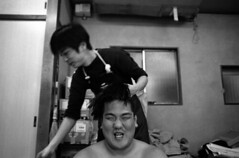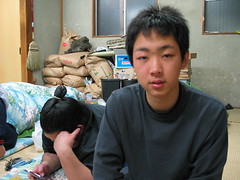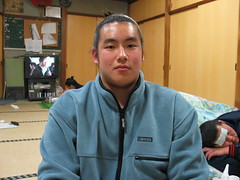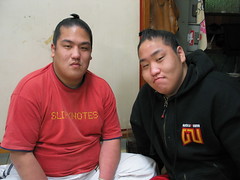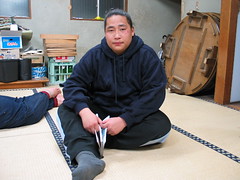But as uneventful and anticlimactic as it was, last Monday was not my last time in a mawashi. The next day—my second to last in the stable—I put one on again, only this time it was for mochi-tsuki. Mochi are the chewy rice cakes that are eaten year-round in Japan, but are especially popular during the New Year's holiday. Mochi-tsuki is the traditional way of making mochi, by hammering cooked glutinous rice with a giant mallet into a sticky paste. Temple congregants, school groups, residents in the same neighborhood and sometimes even the same condominium will take turns banging the hell out of piles and piles of rice to make mochi around New Year's. The Japanese, in fact, have never heard of the man in the moon, but they do think they can see a giant rabbit making mochi with a mallet in the lunar craters.
And since sumo wrestlers take everything that is traditionally Japanese and do it more intensely than the rest of the country, mochi-tsuki at the stable was a very big deal. On Monday night, the wrestlers laid a giant plastic tarp over the dohyo, on which it stood a huge stone bowl. They also set 130 pounds of rice soaking in a plastic garbage can and arranged a tower of old-fashioned bamboo rice steamers over a contraption that boiled water on a portable burner in the corner of the practice floor.
Early the next morning, they put on their mawashi and got to work. Two old guys—supporters of the stable and, apparently, mochi-making experts—came to oversee the operation. First the wrestlers cooked rice in the bamboo steamers, as well as in the more modern metal ones they used on the kitchen burners. Then they dumped the rice into the stone bowl, where four wrestlers mashed it up, each using a narrow wooden mallet like a pestle.
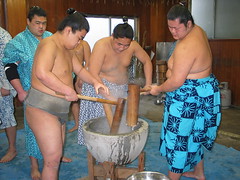
When the rice had been crushed, a single wrestler stepped in with a big, heavy wooden mallet and started hammering on the crushed rice, while someone else flipped around the rice mush between blows. Each time the hammer struck the rice, all the wrestlers would chant, "Yo-i-sho!"
The wrestlers were just getting started when I came downstairs.
"Are you going to help?" asked Ishikawa.
"Sure, I'd like to," he said.
"Then you should put on a mawashi," Hiroki said.
"Nah, he doesn't have to," disagreed Ishikawa. He pointed to me in my sweat clothes. "He's okay like that."
But I cut in, "It's okay. I'll put on a mawashi." I actually wanted to put one on, since I'd leave the stable soon and didn't yet have a picture of myself in one.
Tatsuya helped me into a mawashi back down the hall. I staged a couple photos of me shiko-ing and wrestling with Nakahara, the biggest guy around at the moment, then joined the wrestlers around the stone bowl. I hung back, silently waiting my turn to hammer at the rice, until Mitsui told me I had to say "Yo-i-sho!" when someone struck the inside of the bowl, so I started chanting along.
When it was finally my turn, I eschewed the lighter, narrow mallet that they suggested I use and took up the big one. I lowered it down on the glob of mashed-up rice. "Yo-i-sho!" everyone shouted. I lifted the mallet back up and lowered it again, then again. Between each blow, the Kashira lifted the congealing pile of rice and flipped it over, so it would be evenly beaten. My first couple dozen or so hammers were easily done, and I kept the wrestlers chanting at an even cadence.
But then my arm started hurting, and the hammer got heavy. It started taking me longer and longer to lift the mallet back over my shoulder. I'd lift it out of the stone bowl and the wrestlers would start saying, "Yo-i…" but then they'd have to draw it out until I had the mallet up in the air and finish with a "…sho!" as I dropped it. So I passed my mallet on to Kitamura and got out of the way.
Back away from the stone bowl, the Sekitori, who knew I was moving out the next day, said, "So, are you going to become a sumo wrestler?"
"Me?" I asked.
"Yeah," he said, "you're pretty strong," which, of course, was untrue, as my performance with the mallet demonstrated.
"But I'm too old," I replied. "And too short."
"He's short too," he said, pointing at Ishikawa, who is at least a few inches taller than me.
"Then maybe I will become a sumo wrestler," I said.
In fact, though, not only did I not want to be a sumo wrestler, I didn't even feel like being in a mawashi anymore. I got my photos and took a few cracks at the rice. That was enough. So I put on the robe they'd given me after my first time in the dohyo and slipped away to change. In the hall by the laundry room, I struggled out of the mawashi that clung to my legs like an octopus, and then went upstairs, holding onto to my robe to keep it shut.
But when I reached the top of the steps, I was surprised to see a pointy pair of women's zippered boots outside the room. When I slid open the door, there was Iki sitting on the floor sorting photographs next to a girl in a short skirt and thigh-high stockings.
I did a double take. I had never seen a woman in the stable's upper levels, and had only seen a small handful even in the common room. It never even occurred to me that a woman could exist in the wrestlers' bedroom: it was such a boys' room. But there she was. She was hot too, and in her early twenties if that.
I tottered at the door, unsure if I was seeing a mirage. Then, finally, I said, "Konnichi wa," and walked in.
"Harry Potter!" Iki greeted me. Then to the girl, he said, "You speak English, talk to him."
But instead, she told a story—in Japanese—about a Chinese "client" who told her—in English—that he was 99 years old. She clearly came from Iki's demimonde.
And there I was, naked under my goofy Japanese robe, wondering how I was going to get into the jeans I'd come upstairs to put on. I'd lost most modesty over the past couple weeks, bathing and changing in groups, and would have dropped my robe without thinking if the dudes were the only ones in the room. But I couldn't do that now, so I collected my clothes into a bundle to bring downstairs.
I came back up dressed normal and the girl said, "You changed your clothes."
"Yes, I did," I answered and settled down against my rolled up bedding to type up some notes. Iki snagged a pair of enormous pants from one of the wrestlers' laundry piles and put them on over the plaid shorts he'd been lounging in. Then he left with the girl, leaving behind his metal briefcase, Louie Vuitton handbag and photo albums.
This actually wasn't the first time I'd seen Iki since my first day at the stable, when he barged in during the wrestlers' naptime. Now and then he'd just appear. Sometimes he sat on the floor taking calls on one of his two cell phones; sometimes he slept for a few hours, then left.
One night he came in wearing the same orange velour jogging suit I met him in—which looked dirtier each time I saw it—and, singing a few bars of Let It Be, he rolled out Saita's bedding and got comfortable
"Harry Potter," he said, putting more photos into a cardboard album. "You look like Harry Potter."
"No I don't," I said.
"It's good to look like Harry Potter," he said. "Harry Potter's handsome."
"Harry Potter's a little kid," I said.
"Not in the last movie," he said. "Did you see the last movie?"
I had to admit that I hadn't.
Later he complimented me on my nose.
"That's a handsome nose," he said.
"No it's not," I said. "It's a big nose."
"It's a nice nose," he said. "It's nice because it's big."
"In America, people with big noses get operations to make them smaller," I told him.
"People here get operations to make their noses bigger," he said. He was considering an operation to make his own nostrils narrower, he added.
Soon after that he asked, "Is Japanese food tasty?"
"Yes, it is," I said.
"Are Japanese girls sexy?" he continued.
"Sure, they're nice," I answered.
"Nice?" he said. "Have you done one?"
"Shut up," shouted Murayoshi from his futon, where he was watching television, before I could tell Iki I wasn't going to answer him.
Iki also made an appearance the morning of the dohyo-tsukuri, while everyone was outside stuffing the tawara. He showed up on a bicycle, wearing dark-blue bell-bottom dungarees and a matching jean jacket. I was taking photos and asked if I could take his picture. He posed doing something that looked like a cross between vogueing and firing six-shooters into the air.
"Japanese geisha boy," he crooned about himself in English.
What the hell was up with this guy? I often wondered. What was his business at the stable? How does he fit into the dynamic, the hierarchy? What purpose does he serve?
I found myself wondering this again after he left the stable with the little prostitute or hostess or whatever she was. My curiosity got the better of me: I decided to rifle through the photo albums he left on the floor.
One just had pictures of women drinking together, women drinking with him in a suit, women drinking with other glammed-out Japanese guys. I assumed that, like the photos he showed me himself the day I met him, they were taken at the club where he works as a host.
But the other album was more intriguing. It had pictures of the wrestlers, mostly the older ones, singing karaoke and drinking with attractive women wearing revealing dresses and significant sums of makeup.
Suddenly it dawned on me: Was Iki the stable's pimp?
NEXT:
Stablemates I
